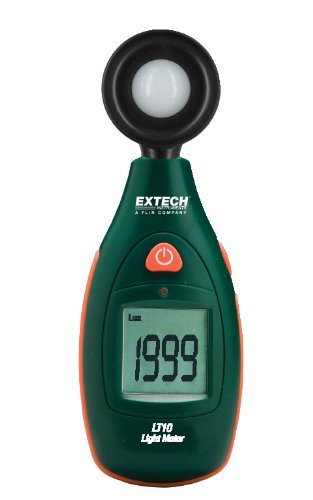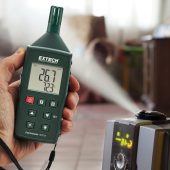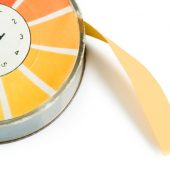A light meter, also called a lux meter, measures the brightness of a place, person or object. It can also measure the intensity of a light source such as an LED lamp.
One obvious use of a light meter is in photography, where proper lighting is crucial in achieving the right level of exposure.
Most cameras come with built-in light meters. But many pro photographers and cinematographers prefer the accuracy and ease of use of a handheld light meter.
Light meters are also common in ensuring workplace safety standards. They are used to make certain work desks and other areas are well lit. Other applications include LED manufacturing, laboratories, museums, and art archives.
In this buying guide, we review the best light meters you can buy online and explain what features to look for when choosing the best light meter for your needs.
What to Consider When Choosing a Light Meter
a) Type of Light Meter
There are two types of lux meters: those that measure incidental light and those that measure reflected light.
Reflected light meters measure the light that bounces back from a person or object. All light meters in cameras are this type.
But reflected light meters have a significant limitation. Because the amount of reflected light depends on the properties of the object – such as colour – they are easily ‘deceived’ into thinking an object is brighter or darker than it is.
For example, a white object would reflect a lot of light, leading to high lux readings. A dark coloured object, on the other hand, would register lower readings even with bright light falling on it.
To solve this problem, many pros and photographers use incident light meters. These measure the amount of light that’s falling on a person or object.
Because it does not depend on the reflective properties of the subject, an incident light meter is more accurate.
Where a reflected meter can be helpful is when you are photographing a faraway object such as a skyscraper. Since you cannot place the incident light meter close enough to measure the light falling on it, a reflected light meter is the best tool.
Some light meters combine both incident and reflected light measurements. By switching accessories – a flat disk for reflected light and half sphere for incident light – you can measure whichever type of light is most appropriate for the situation.
All our picks below are incident light meters, though a couple offer both incident and reflected light measurements.
b) Digital vs. Analogue
Digital and analogue light meters work the same way. The difference is in how they display results.
An analogue meter uses a needle to indicate light intensity. In contrast, a digital meter shows the precise measurements on a screen.
Digital meters are the most common, and they are the best. You get a more accurate reading. Additionally, most have internal memory storage, allowing you to access stored measurements.
Some meters have both analogue and digital displays.
c) Backlit Display
Make sure the meter’s display is backlit. It makes it easy to take light readings in any level of lighting.
To conserve the battery, look for a meter with a backlit display button that allows you to turn on the light only when you need it. Alternatively, get a light meter with a light sensor that automatically turns on the backlight only when it’s dark.
d) Settings & Functions
Here are the most important settings and functions to look for in a light meter.
- Hold mode: Pressing the hold button on a lux meter freezes the measured value.
- Peak hold: The peak hold button displays the highest recorded value.
- Min and max mode: Records the minimum and maximum values.
- LUX/Fc button: Changes display units from Lux to foot-candles.
e) Range
Check the maximum readings the light meter can record. The higher the range, the more versatile the light meter, meaning you can use it in a wide variety of environments.
Cheap light meters have a range of up to 40,000 Lux. Midrange light meters go up to 100,000 Lux and premium models can have a range up to 400,000 Lux.
f) Accuracy
For the highest accuracy, look for a light meter with a high resolution. Resolution is the smallest measurement change a light meter can take.
The best light meters have a resolution of 0.01 Lux. They can detect tiny differences in brightness, thus offering more accurate readings. High-accuracy light meters are useful for applications such as calibrating LED lamps and in photography.
Lower cost light meters have a resolution of 1 Lux. They are ideal for situations where a high degree of precision is not necessary, such as when measuring the brightness of an office.
Something to check when it comes to accuracy is whether the light meter comes with a calibration certificate, which guarantees the light meter has been calibrated accurately.
Note: Depending on your work environment, you may need to maintain an annual calibration certificate for your light meter. Some light meter manufacturers sell this certificate separately. You can also get your light meter calibrated by a third party and receive a calibration certificate.
g) Remote vs. Fixed Sensor
When it comes to the sensor, there are two types of light meters: those with a fixed sensor and those with a remote sensor.
Fixed sensor light meters have the sensor fixed permanently on the body of the meter. You have to move the entire unit to take measurements.
The main advantage of a fixed sensor is compactness. The light meter is smaller and can easily fit in your pocket. You can also hold and use it with one hand.
Remote sensor light meters have the sensor attached to a long cable, which allows you to take measurements a distance away from the main unit.
A remote sensor light meter is useful when you need to take measurements in tight spaces where the main unit cannot fit.
The downside of a remote sensor is bulkiness. It’s not easy to fit the light meter in your pocket, and you have to use both hands to take measurements.
- Read also: How To Choose The Best Hygrometer In The UK?
h) Additional Features
Here are some additional features to look for.
- Tripod socket: Some light meters have a tripod socket, which allows you to attach it to a tripod. A tripod attachment is handy when you need to take lots of measurements such as tracking the brightness inside a room throughout the day.
- Additional light measurements: In addition to measuring luminance, some light meters also measure other parameters such as contrast and colour temperature.
- Carry case: If you plan to travel a lot with the light meter, look for one that comes with a protective carrying case.
- Auto shut-off: Automatic shut-off turns the meter off after a few minutes of inactivity to extend battery life.
The Best Light Meters Reviews
1. Testo 0560 0540 Lux Meter Review

The Testo light meter offers quick and accurate luminance measurements using a fixed light sensor.
It is designed specifically for measuring light intensity in offices and other work environments. The silicone sensor is calibrated to match the sensitivity of the human eye, which ensures the best level of lighting for employees.
You can measure up to 99999 Lux with a resolution of 1 Lux up to 19999 Lux. Beyond that, accuracy decreases to a resolution of 10 Lux.
But for office measurements, you’ll likely never need to go above 500 Lux.
By the way, the Tiesto light meter comes with a calibration certificate so you can be sure it is accurate.
The Testo light meter has a large display with easy to see numbers. The screen is backlit for easy reading in any kind of lighting.
The control panel is simple with just three buttons for power on/off, hold function, min/max values and switching from Lux to Fc.
Compact and weighing just 95g, the Testo light meter fits easily in your pocket for easy portability to any job site.
2. Extech Instruments LT300 Light Meter Review
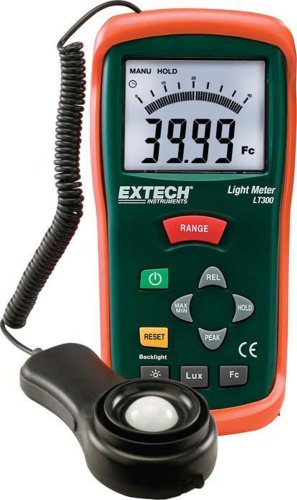
If you prefer a light meter with a remote light sensor, we recommend the Extech LT300 Light Meter.
The sensor is attached to the end of a 12” coiled cable. You can extend the cable to 24”.
The Extech light meter has double the range of the Testo meter (200,000 Lux), giving you more versatility.
Resolution is 0.01 Lux, which is also higher than Tiesto. The Extech light meter is generally a great choice for pros who need to take precise measurements, sometimes in tight areas.
The Extech light meter doesn’t come with a calibration certificate, but users who have tested it say it is accurate.
The LCD is big and shows both numbers as well as a bar graph.
You can record min and max values, select hold or peak hold mode, and switch between Lux and foot-candles.
The screen is backlit though you can turn off the light when you don’t need it to save battery.
The light meter is a bit bulky because of the remote sensor, and you need to use both hands to take a reading.
For easy portability, it comes with a carrying case and a protective holster. Other accessories include a 9V battery and a protective cover for the sensor.
3. Extech Instruments LT45 LED Light Meter Review

If your work involves testing the amount of LED lighting in an office or workplace, the Extech Instruments LT45 is the best light meter. It is designed specifically for LEDs, both white and coloured.
The LT45 light meter has a remote sensor attached to the end of a coiled cable. The cable can expand to 1.5m.
The max measurement the LT45 can take is 400,000 Lux with an accuracy of ±3%.
The display is large and easy to read. Below it are buttons for measurement units (Lux, Fc or CD), hold, zero calibration and min/max readings.
Accessories provided with the LT45 include a protective cover for the sensor, a hard carrying case and a 9V battery.
4. Extech LT10 Pocket Light Meter Review
Need a compact and light meter you can carry in your pocket? We recommend the Extech LT10.
Despite its small size, the LT10 can measure light intensity up to 400,000 Lux. It also comes with a surprisingly large backlit display. The backlight comes on automatically based on ambient light conditions.
The silicone light sensor is fixed at the top of the light meter, making for easy one-handed operation.
Other than the power button, the LT10 has just one other multifunction button conveniently located on the side where you can easily reach it with your thumb.
This button lets you switch between Lux and Fc and displays the max reading.
5. Sekonic FLASHMATE L-308X Photographers and Film Makers Exposure Meter Review
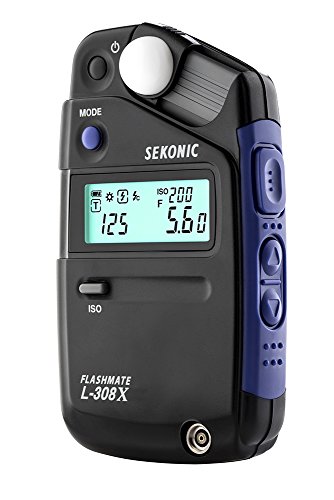
For photographers and videographers, the Sekonic FLASHMATE L-308X is the best light meter. It is designed specifically for photography.
The FLASHMATE L-308X allows you to set the right aperture and speed settings. The ISO range is 3 to 8,000. You can also select ISO 850 for filmmaking. The aperture range is F0.5 to 90.9.
You can measure both incident light and reflected light. Just slide the sphere to reveal the 40-degree reflected light lens.
You can switch the meter to one of the three modes: photo, cine and HD cine. Each mode gives you access to different features and settings.
The FLASHMATE L-308X comes with a large backlit display that comes on automatically in dim light. The package also includes a safety strap, a carrying case and a terminal cap.
The only thing not included is an AA battery. You need just one to power the light meter.
The L-308X light meter is small enough to hold in on hand and fit in your pocket.

